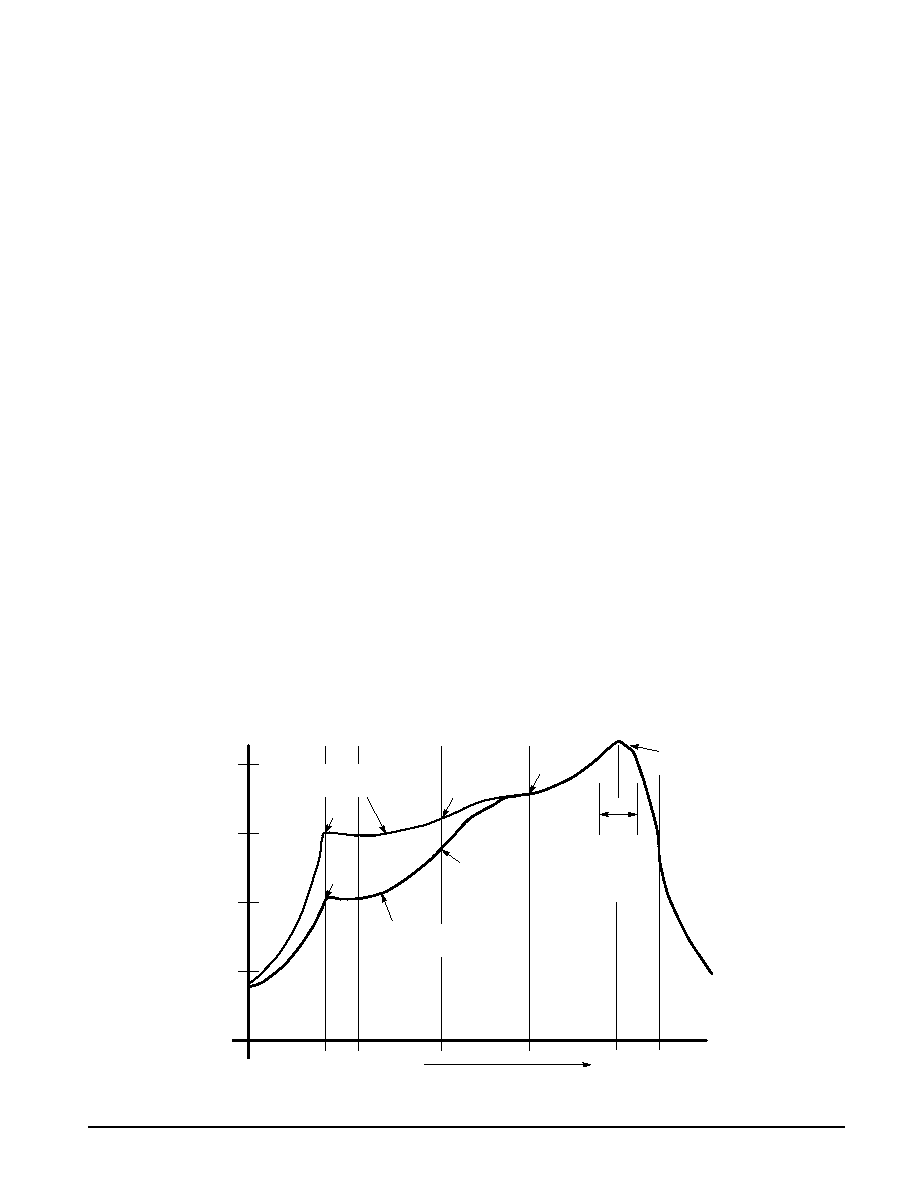- 您現(xiàn)在的位置:買賣IC網(wǎng) > PDF目錄296651 > MURHB840CTT4 (MOTOROLA INC) 4 A, 400 V, SILICON, RECTIFIER DIODE PDF資料下載
參數(shù)資料
| 型號(hào): | MURHB840CTT4 |
| 廠商: | MOTOROLA INC |
| 元件分類: | 參考電壓二極管 |
| 英文描述: | 4 A, 400 V, SILICON, RECTIFIER DIODE |
| 文件頁(yè)數(shù): | 4/6頁(yè) |
| 文件大小: | 107K |
| 代理商: | MURHB840CTT4 |

MURHB840CT
4
Rectifier Device Data
GENERAL SOLDERING PRECAUTIONS
The melting temperature of solder is higher than the rated
temperature of the device. When the entire device is heated
to a high temperature, failure to complete soldering within a
short time could result in device failure. Therefore, the
following items should always be observed in order to
minimize the thermal stress to which the devices are
subjected.
Always preheat the device.
The delta temperature between the preheat and soldering
should be 100
°C or less.*
When preheating and soldering, the temperature of the
leads and the case must not exceed the maximum
temperature ratings as shown on the data sheet. When
using infrared heating with the reflow soldering method,
the difference shall be a maximum of 10
°C.
The soldering temperature and time shall not exceed
260
°C for more than 5 seconds.
When shifting from preheating to soldering, the maximum
temperature gradient shall be 5
°C or less.
After soldering has been completed, the device should be
allowed to cool naturally for at least three minutes.
Gradual cooling should be used as the use of forced
cooling will increase the temperature gradient and result
in latent failure due to mechanical stress.
Mechanical stress or shock should not be applied during
cooling
* Soldering a device without preheating can cause excessive
thermal shock and stress which can result in damage to the
device.
* Due to shadowing and the inability to set the wave height to
incorporate other surface mount components, the D2PAK is
not recommended for wave soldering.
RECOMMENDED PROFILE FOR REFLOW SOLDERING
For any given circuit board, there will be a group of control
settings that will give the desired heat pattern. The operator
must set temperatures for several heating zones, and a figure
for belt speed. Taken together, these control settings make up
a heating “profile” for that particular circuit board. On
machines controlled by a computer, the computer remembers
these profiles from one operating session to the next. Figure
6 shows a typical heating profile for use when soldering the
D2PAK to a printed circuit board. This profile will vary among
soldering systems but it is a good starting point. Factors that
can affect the profile include the type of soldering system in
use, density and types of components on the board, type of
solder used, and the type of board or substrate material being
used. This profile shows temperature versus time. The line on
the graph shows the actual temperature that might be
experienced on the surface of a test board at or near a central
solder joint. The two profiles are based on a high density and
a low density board. The Vitronics SMD310 convection/in-
frared reflow soldering system was used to generate this
profile. The type of solder used was 62/36/2 Tin Lead Silver
with a melting point between 177 –189
°C. When this type of
furnace is used for solder reflow work, the circuit boards and
solder joints tend to heat first. The components on the board
are then heated by conduction. The circuit board, because it
has a large surface area, absorbs the thermal energy more
efficiently, then distributes this energy to the components.
Because of this effect, the main body of a component may be
up to 30 degrees cooler than the adjacent solder joints.
STEP 1
PREHEAT
ZONE 1
“RAMP”
STEP 2
VENT
“SOAK”
STEP 3
HEATING
ZONES 2 & 5
“RAMP”
STEP 4
HEATING
ZONES 3 & 6
“SOAK”
STEP 5
HEATING
ZONES 4 & 7
“SPIKE”
STEP 6
VENT
STEP 7
COOLING
200
°C
150
°C
100
°C
50
°C
TIME (3 TO 7 MINUTES TOTAL)
TMAX
SOLDER IS LIQUID FOR
40 TO 80 SECONDS
(DEPENDING ON
MASS OF ASSEMBLY)
205
° TO 219°C
PEAK AT
SOLDER JOINT
DESIRED CURVE FOR LOW
MASS ASSEMBLIES
DESIRED CURVE FOR HIGH
MASS ASSEMBLIES
100
°C
150
°C
160
°C
170
°C
140
°C
Figure 6. Typical Solder Heating Profile for D2PAK
相關(guān)PDF資料 |
PDF描述 |
|---|---|
| MURHB860CT | 4 A, 600 V, SILICON, RECTIFIER DIODE |
| MURS120CSM4 | 1 A, 200 V, SILICON, SIGNAL DIODE |
| MUSB-05-F-AB-SM-A-TR | 5 CONTACT(S), MALE, RIGHT ANGLE TELECOM AND DATACOM CONNECTOR, SURFACE MOUNT |
| MUSB-05-S-AB-SM-A-TR | 5 CONTACT(S), MALE, RIGHT ANGLE TELECOM AND DATACOM CONNECTOR, SURFACE MOUNT |
| MUSBMUSB-05-F-AB-SM-A | 5 CONTACT(S), FEMALE, RIGHT ANGLE TELECOM AND DATACOM CONNECTOR, SURFACE MOUNT |
相關(guān)代理商/技術(shù)參數(shù) |
參數(shù)描述 |
|---|---|
| MURHB840CTT4G | 功能描述:整流器 400V 8A Ultrafast RoHS:否 制造商:Vishay Semiconductors 產(chǎn)品:Standard Recovery Rectifiers 配置: 反向電壓:100 V 正向電壓下降: 恢復(fù)時(shí)間:1.2 us 正向連續(xù)電流:2 A 最大浪涌電流:35 A 反向電流 IR:5 uA 安裝風(fēng)格:SMD/SMT 封裝 / 箱體:DO-221AC 封裝:Reel |
| MURHB860CT | 功能描述:整流器 600V 8A Ultrafast RoHS:否 制造商:Vishay Semiconductors 產(chǎn)品:Standard Recovery Rectifiers 配置: 反向電壓:100 V 正向電壓下降: 恢復(fù)時(shí)間:1.2 us 正向連續(xù)電流:2 A 最大浪涌電流:35 A 反向電流 IR:5 uA 安裝風(fēng)格:SMD/SMT 封裝 / 箱體:DO-221AC 封裝:Reel |
| MURHB860CT/D | 制造商:未知廠家 制造商全稱:未知廠家 功能描述:MEGAHERTZ? Power Rectifier |
| MURHB860CTG | 功能描述:整流器 600V 8A Ultrafast RoHS:否 制造商:Vishay Semiconductors 產(chǎn)品:Standard Recovery Rectifiers 配置: 反向電壓:100 V 正向電壓下降: 恢復(fù)時(shí)間:1.2 us 正向連續(xù)電流:2 A 最大浪涌電流:35 A 反向電流 IR:5 uA 安裝風(fēng)格:SMD/SMT 封裝 / 箱體:DO-221AC 封裝:Reel |
| MURHB860CTT4 | 功能描述:整流器 600V 8A Ultrafast RoHS:否 制造商:Vishay Semiconductors 產(chǎn)品:Standard Recovery Rectifiers 配置: 反向電壓:100 V 正向電壓下降: 恢復(fù)時(shí)間:1.2 us 正向連續(xù)電流:2 A 最大浪涌電流:35 A 反向電流 IR:5 uA 安裝風(fēng)格:SMD/SMT 封裝 / 箱體:DO-221AC 封裝:Reel |
發(fā)布緊急采購(gòu),3分鐘左右您將得到回復(fù)。